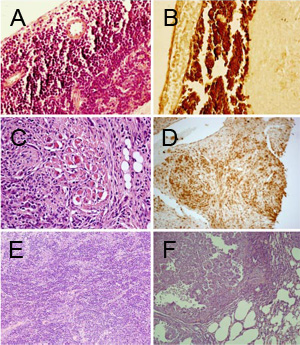What drives cancer?

A new method has been developed to screen thousands of gene mutations for their ability to cause cancer. The method will mean that researchers can more rapidly find the most important mutations in tumour samples.
Cancer is a disease in which the genome is ravaged by mutations. It is known that several mutations are most often required for development of cancer, but the high levels of DNA damage in many tumours can make it difficult to determine which mutations are involved in causing the cancer (driver mutations) and which are unimportant side-effects of the disease (passenger mutations).
The new method, published in Proceedings of the National Academy of Sciences this week, allows researchers to screen thousands of genes in hundreds of tissue at one time. The technique should allow cancer researchers to establish rapidly which mutations are drivers and which are passengers, leading more swiftly to identification of important targets for development of diagnostics and therapies.
“Genome-wide cancer studies are uncovering hundreds of mutations from tens of tissues, but we face a challenge in determining which are driving the development of cancer. Computer analyses can guide efforts, but give only a partial picture.
“Our robust in vivo system should rapidly take us from many possible mutations to the small number of critical mutations, speeding work to understand the biology of cancer and to define important diagnostic or therapeutic targets.”
Dr Pentao Liu Investigator at the Wellcome Trust Sanger Institute
The activity of protein-coding genes is exerted through nearby regulatory sequences that do not themselves produce/code for protein but effectively control the activity of the adjacent gene. These promoter sequences act to switch a gene on or off, up or down, in the appropriate cells at the appropriate time.
The novel system uses DNA transposons – unusual DNA sequences that can hop around a genome – to carry possible cancer gene segments into new locations in the mouse genome. Initially, the cancer genes are inserted into one location in the genome. The researchers then use a genetic trick to make the genes jump out of the genome and into multiple new locations. A transposon called Sleeping Beauty induces transposition of the cancer genes: if a cancer gene jumps close to a promoter, then it will be controlled by those sequences.
“The mice harbouring these transposons are free of disease because the cancer genes are silent before transposition, but after transposition, the cDNAs are excised from the genome and reintegrate into new loci across the genome. The oncogene cDNAs have the opportunity to search the entire genome for the optimal regulatory elements, for the appropriate temporal points, and for the right cellular compartments to exert their oncogenic potential.
“The transposons do our promoter selection for us.”
Professor Allan Bradley Director of the Wellcome Trust Sanger Institute
Sleeping Beauty DNA transposition creates combinations of activation of these genes, effectively ‘screening’ billions of cells in one mouse.
The team showed that many mice developed multiple tumours, including major human types such as carcinomas, sarcomas, and hematopoietic malignancies. The results show that the genes studied have the potential to cause cancer in different tissues or organs. They also show that the levels of activity of the cancer gene can be low: it is not necessary in many cases to drive high levels of activity.
“Our DNA transposon-based platform allows us to explore the oncogenic potential of thousands of genetic mutations in the mouse.Conventional transgenic research requires prior selection of which promoter sequence to use: ours is a largely unbiased approach that can scan many hundreds or thousands of promoters.”
Dr Pentao Liu Investigator at the Wellcome Trust Sanger Institute
The team is optimistic that their approach will add biological understanding to the flow of genomic information from projects such as the Sanger Institute’s Cancer Genome Project and the International Cancer Genome Consortium.
The study is the result of a collaboration between researchers at the Wellcome Trust Sanger Institute, the Japanese Foundation for Cancer Research, the Department of Anatomy and Cell Biology, University of Iowa, and the Institute of Molecular and Cell Biology, Singapore.
More information
Funding
This work was supported by The Wellcome Trust.
Collaborating Institutions
- Wellcome Trust Sanger Institute, Hinxton, Cambridge, England
- The Cancer Institute, Japanese Foundation for Cancer Research, 3-10-6 Ariake, Koto-ku, Tokyo, Japan
- Department of Anatomy and Cell Biology, University of Iowa, 51 Newton Road, Iowa City, IA, USA
- Institute of Molecular and Cell Biology, 61 Biopolis Drive, Proteos, Republic of Singapore
Publications:
Selected websites
The Wellcome Trust Sanger Institute
he Wellcome Trust Sanger Institute, which receives the majority of its funding from the Wellcome Trust, was founded in 1992. The Institute is responsible for the completion of the sequence of approximately one-third of the human genome as well as genomes of model organisms and more than 90 pathogen genomes. In October 2006, new funding was awarded by the Wellcome Trust to exploit the wealth of genome data now available to answer important questions about health and disease.
The Wellcome Trust
The Wellcome Trust is a global charitable foundation dedicated to achieving extraordinary improvements in human and animal health. We support the brightest minds in biomedical research and the medical humanities. Our breadth of support includes public engagement, education and the application of research to improve health. We are independent of both political and commercial interests.


